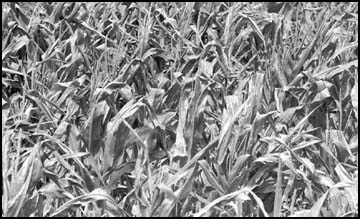 Area farmers are optimistic about their crops this summer. Where the soils are heavier, the crops are still looking pretty good. However, in areas of lighter soil which are not irrigated, corn crops are shriveling and turning brown (see photo).
Area farmers are optimistic about their crops this summer. Where the soils are heavier, the crops are still looking pretty good. However, in areas of lighter soil which are not irrigated, corn crops are shriveling and turning brown (see photo).The rain on Monday was a welcome sight to area farmers.
"It seemed like there was a bubble over the area and the rain usually missed us," Richard Lahr, who farms east of Paynesville, said.
Lahr said the crops planted on lighter soils are burning up. He has 400 acres planted in crops of which 40 acres are damaged by the heat and dry weather, 200 acres are borderline and the balance he still considers good.
"The corn doesn't look too bad but it needs rain," he stressed. Lahr added that the third crop cutting of alfalfa is less than normal due to the dry summer.
"Most of our soil is heavy and the crops don't look too bad," Mrs. Oluf Johnson, who farms south of Paynesville, said. "We should get a good crop as long as we don't get any hail now. At least we haven't received any of the major storms this summer."
Roger Bagley at the Regal Elevator said the crops can't compare to last year because of the lack of rain and hot summer temperatures. "The oats crop averaged 74 to 80 bushels to the acre but the test weight is light," he added.
"The crops need moisture. The corn planted on lighter soils is lost, burned out, and in many areas the soybeans are showing stress," Bagley said.
Celestine Fischbach at the Paynesville Grain and Feed, agreed that some fields are ruined. "Where the fields are irrigated, they'll have a crop, the nonirrigated areas are burning," he said.
Fischbach said the oats harvest is under way and the test weight is on the low side, averaging 29 to 34. The normal range is 36 to 38 pounds per bushel.
"The cutting of the third crop of hay is also under way and the alfalfa is on the short side. Where there is heavy soil, farmers will have a third crop," he added.
Fischbach, who farms north of Lake Henry, said Lake Henry has heavier soil and doesn't really need a heavy rain. The area has received timely light showers which have helped the crops progress.
"Besides the dry field conditions, the prices are going to hurt the farmers more," Fischbach said. "Corn prices are $1.50 per bushel. Soybeans are $4.10 to $4.15 per bushel. For a while they were down to $3. Last year at this time they were $5 per bushel. The price for oats is 90 to 95 cents, and then the price is docked more for the low test weight."
"All farmers can do is keep their fingers crossed and maybe the prices will come up before the fall harvest is in full swing. One never knows what the markets will do," Fischbach added.
John VanderBeek at the Cenex fertilizer plant agreed with Fischbach that the prices will be more of an issue than the weather. "The last three years the crops have been great, the farmers have had their expectations set high again for this year," VanderBeek said. "However, this year is closer to normal. Farmers are reporting the crops are burning on lighter soil."
VanderBeek said the potato leaf hopper is affecting the quality of the third crop alfalfa cutting. Farmers have been busy spraying to lessen the damage in the fields from the hoppers.
According to the Minnesota Agricul-tural Statistics Service, crops continued to grow well where recent rainfall has been sufficient.
In parts of Minnesota, flooded areas in fields, which followed heavy rains the previous week, receded quickly with the heat. Even where low spots had drowned out, surrounding stands of late season crops generally benefitted from the abundant moisture, although there remains some root and leaf disease threats.
Rainfall amounts have been highly variable, even within counties, particularly in central Minnesota. Corn and soybeans in the drier spots are thought to have suffered some damage from scorching heat during their pollination stages.
Topsoil moisture statewide as of July 30 was two percent very short, 15 percent short, 71 percent adequate, and 12 percent surplus.
An estimated 96 percent of the state's corn acreage was tasseling, and 22 percent had entered milk stage as of Aug. 1.
Soybeans are 92 percent blooming versus 98 percent a year ago and 91 percent for the five-year average.
Other small grain harvest estimates include nine percent barley, 21 percent of oats, 24 percent of winter wheat and 41 percent of rye.